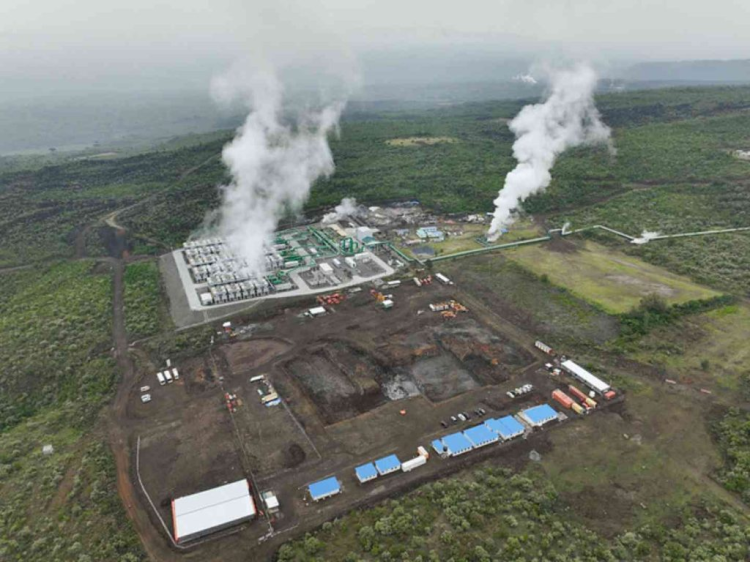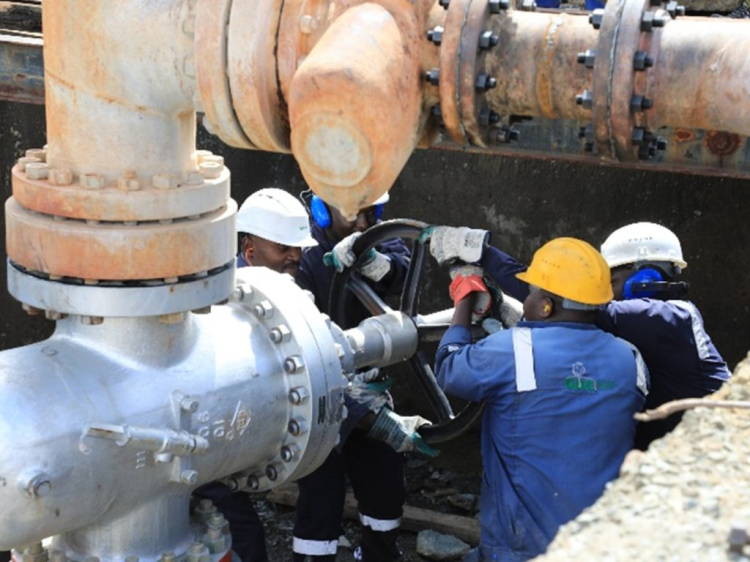Kenya's next geothermal power plant is being constructed within an area the size of 10 football pitches, nestled inside a volcanic caldera - and it's a hot deal. The 35MW power plant by Orpower Twenty-Two completes the 105MW Menengai Geothermal Project spearheaded by the Geothermal Development Company (GDC).
On that bright October (2024) day when the President of Kenya, Dr William Ruto, launched construction of the power plant, Menengai was abuzz.
The President encountered a typical construction site. At the Globeleq and Orpower Twenty-Two sites, a fleet of bulldozers, tippers, excavators, and workers in hard hats and reflector jackets operated in synchrony towards the goal of delivering more green power for Kenya. This is the theatre where the country's energy future is unfolding.
In this episode of ESI Africa Insights, Rural Electrification and Renewable Energy Corporation (REREC) Board Director Mark Nderitu shares insights into Kenya's energy landscape, highlighting geothermal leadership, solar growth and national connectivity ambitions
Contact our sales team to position your smart solution
But it was the moment the president operated the digger scooping soil and dumping it into the trailer of a waiting tipper that marked a symbolic turning point for Kenya's geothermal fortunes. If there was ever a moment of pride in geothermal development, this was it. The President reaffirmed his strong conviction in green energy.
It also, beyond a shred of doubt, demonstrated how public-private partnerships can drive major geothermal infrastructure projects. Crucially, it decisively set the country on a path toward lower electricity costs and a decarbonised economic regime.
In Kenya's energy landscape, geothermal towers above the rest
The 105MW phase includes three power plants, each operated by a different Independent Power Producer (IPP), and each with a 35MW target. Sosian Power is already generating 35MW, while Globeleq was 40% complete at the time of going to press.
Orpower Twenty-Two will invest $90 million in its plant, expected to become operational in 14 months. Globeleq is investing $91 million, while Sosian committed a similar amount. These green investments are significant.

The Menengai Geothermal Project. Source: AfDB/ Flickr
Enhancing the energy profile of Kenya
Once complete, the 105MW will dramatically enhance the country's energy profile, adding stable, affordable and clean energy to the grid. It will also unlock further investment opportunities within Kenya's robust geothermal ecosystem. Beyond the technical achievements, the success of Menengai is a major psychological boost for the nation.
Indeed. In his book, Energy and Civilisation: A History, Vicalv Smil bills energy as the universal currency and argues "to become rich, requires a substantial increase in energy use "
Have you read? Kenya: Transmission line to boost geothermal energy flow
That's spot on. But to consume, we need to generate. And that's how Menengai fits into the bigger wealth of our country.
Grid stability is vital, especially considering the challenges posed by intermittent sources such as solar and wind. Geothermal remains Kenya's premier fuel source - reliable, available, and homegrown.
Kengen Investment Manager Paul Wambugu spoke to ESI Africa at the Green Hydrogen Summit in Cape Town about Kenya's green hydrogen ambition and how their experience with running successful geothermal plants is informing this journey
Geothermal energy has become Kenya's largest source of electricity. With 985MW already installed, it accounts for approximately 48% of the country's power. It also promises to disrupt traditional energy markets, particularly for industrial processes, as more investors seek to harness the immense heat available from steam.
In Kenya's energy landscape, geothermal towers above the rest.
This is excellent news for the economy. Cheaper energy will attract more users. Power will reach health clinics, pump water, light up rural schools, and run dialysis machines in remote locations. Furthermore, it is geothermal energy that will power electric vehicles, operate factories, and attract heavy energy consumers like data centres.
Have you read? Kenya's bold move: Olkaria VII geothermal power approved
Kenya's geothermal growth has been exponential - from 210MW in 2009 to the current 985MW. More capacity is on the way. The additional 70MW planned at GDC's Menengai project will bring Kenya into the "gigawatt club." That milestone was not lost on the President.
"The commencement of this project to establish a 35MW power plant by Orpower Twenty-Two highlights our commitment to unlocking Kenya's vast geothermal potential to drive economic growth. It is also a clear demonstration of our strength in mobilising private sector investment to develop critical infrastructure and provide essential services, thereby accelerating economic transformation," the President said.
Building Kenya's geothermal juggernaut has not been easy. The complexities - from resource mapping to harnessing, and from financing to execution - demand time and major investment. The upstream is particularly risky. That's precisely why GDC exists: to de-risk geothermal fields, make them bankable, and help reduce the cost of power. The Orpower plant forcefully reaffirms that GDC is moving full steam ahead on its mission.
Largely unseen are the geothermal wells that run nearly three kilometres deep, drawing steam that travels through green-clad pipes to turbines. Steam lies at the heart of geothermal power.
Every megawatt generated locally replaces a need to import fossil fuels, saving Kenya precious foreign exchange.
It is this indigenous energy source, abundantly available on Kenyan soil, that also holds the key to powering the nation's industrial ambitions. This helps explain why Nakuru Governor Susan Kihika, speaking at the ground-breaking ceremony, expressed enthusiasm for establishing an industrial park at Menengai. The president reiterated his vision for Nakuru as a "hub of industrialisation."
Have you read? Kenya: Latest Olkaria geothermal energy project 70% complete
Green industrialisation
"Nakuru County, in collaboration with GDC, has set up the Green Industrialisation Taskforce to spearhead accelerated development of green industries which will take advantage of the green energy " Governor Kihika announced.
This model stands as the guiding light for geothermal energy's future. The President was emphatic about the central role geothermal must play in Kenya's economy and green transition. He called on GDC to lead from the front.
A pioneer in attracting private investment for major energy projects, GDC is gaining traction in delivering Kenya's geothermal vision.
Indeed, this is why the president strongly defended the push for green energy, noting that Kenya has proven the feasibility of economic growth powered by renewables.
"The completion of the 105MW Menengai project will elevate Kenya's global ranking to 5th overall, establishing beyond all contestation that economic growth and clean energy development can go hand in hand," he explained.
The global climate conversation is complex and often polarised - marked by denialists and believers, cynics and optimists. Kenya is decisively proving the doubters wrong.
"We are demonstrating that it's possible to be clean, and it's possible to develop," the President reiterated.

March 2025: A GDC Geothermal Resource Management team successfully opened the master valve to discharge a well at the Menengai Geothermal Project. Source: GDCKenya/X
Once completed, the Menengai power plant will be a major boost to Kenya's energy mix. Notably, geothermal power's strengths include being a baseload energy source, boasting an impressive 95% availability rate, and being entirely local. These attributes significantly enhance the country's energy security.
The abundant heat in the Menengai region offers fertile ground for innovative uses, particularly in transforming manufacturing and food production. Lowering electricity costs is a vital component in improving the competitiveness of domestic industry.
Geothermal energy produces cheapest electricity in Kenya
The President emphasised that geothermal energy - especially from Menengai - remains the most affordable option, a key tool in cutting national power costs.
"Given the continually rising fossil fuel prices and the intensifying threat of climate change, investing in renewable energy is efficient, prudent, and sustainable. This is precisely what we are doing with geothermal energy. Upon completion, this plant will generate affordable power at KSh8 per kWh, significantly lower than the cost of fossil fuel alternatives," the President observed.
Have you read? Geothermal energy: Blowing steam up Africa's Rift Valley
Paul Ngugi, GDC's Managing Director and CEO, lauded the business model used at Menengai.
"The groundbreaking of the third power plant at Menengai is a milestone for GDC and Kenya. It's also an affirmation of the practicality of our innovative paradigm of de-risking geothermal fields and making them bankable. The third power plant brings to completion Phase I of the Menengai Geothermal Project, which will generate 105MW of affordable, reliable, and green energy," noted Ngugi.
Menengai is a rising geothermal giant that will thunder across the country. It promises to power Kenyan homes and industries. Menengai powers Kenya's hope. It's the future.
Source: This is a Special Report from Kenya's Geothermal Development Company Steam Issue 17. Edited by ESI Africa








